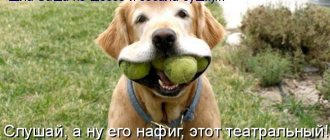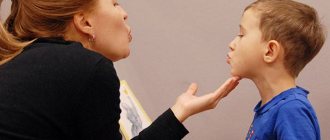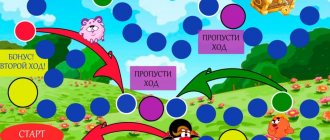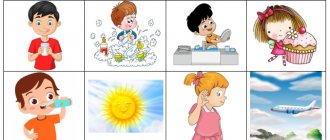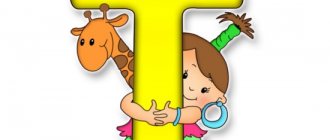We begin automating sounds in words only after the child clearly pronounces an isolated sound and can pronounce it correctly in syllables. We name words, highlighting the automated sound with our voice. We pronounce the words slowly, pronouncing them clearly. It is advisable to repeat the same word 2-3 times.
Articulation of sound [C:
- lips stretched in a smile;
- teeth are closed and exposed (“fence”);
- tip of the tongue behind the lower teeth;
— the air stream is cold (make sure that the air comes out in the middle)
After the correct sound is delivered and fixed in speech in isolation, we move on to repeating syllables and syllable rows.
Automation of the sound [s] in words, sound at the end of the word
Repeat the words, clearly pronouncing the sound C (emphasizing with your voice)
The child repeats the words. We follow the articulation of the sound [s]: the lips are stretched in a smile, the teeth are “fenced”, the tongue is behind the lower teeth, cold air flows along the midline of the tongue.
AS: kvass, bass, us, po-gas, a-na-us. OS: nose, braid, under-nose, braid. US: taste, kak-tus, u-kus, fo-kus, av-bus, fi-kus, min-nus. YS: cape, ku-mys. IS: Denis. YOS: dog, o-ves, o-tes, o-carried. EU: weight, wood, on-weight. JS: in the middle.
Pure sayings with sound Educational and methodological material on the topic
Pure sayings with sound C
A clear phrase is a rhyming phrase in which a sound is often repeated. They serve to practice sound pronunciation, develop voice strength, tempo of speech, sense of rhyme, speech breathing, as well as to correct the lexico-grammatical and phonetic-phonemic aspects of speech.
At the beginning of the work, it is necessary to highlight the “basis” of pure language. To do this, take the last syllable in the word and repeat it at the beginning of the phrase as many times as there are syllables in this word. This turns out to be the “basis” of pure speech, on which the work of sound development takes place.
The proposed pure sayings must necessarily include two parts. The first part should consist of repeated syllables. The second must contain a word of the same number of syllables, ending with a syllable from the first part.
Depending on the level of speech development and the age of the children, pure phrases can be “shortened” (i.e., reduce the number of words, and, conversely, “increased” (i.e., increase the number of repeating syllables and words).
Sa-sa-sa - a wasp is flying. Sa-sa-sa - a fox is sitting under a bush. Sa-sa-sa - Sonya has a braid. Sa-sa-sa - there is a wasp in the forest. So-so-so - Sonya has a wheel. .So-so-so - the tire was deflated.Su-su-su - I saw a wasp.Su-su-su - I was carrying a bag.Su-su-su - berries in the forest.Su-su-su - we saw a fox in the forest .
Su-su-su - mushrooms grew in the forest
Sy-sy-sy - Sanya has beads. Sy-sy-sy - the clock is ticking. Sy-sy-sy - the catfish has a mustache. Sy-sy-sy - there's a clock hanging on the wall. Se-se-se - there's a clock next to the garden highway.As-as-as - we drank kvass from a mug.As-as-as - Sonya had pineapple.As-as-as - we had kvass at home.As-as-as - we drank kvass at ours.Os-os -os - there are a lot of wasps in the clearing. Os-os-os - Sanya has a dog.
Us-us-us - we are bringing home a watermelon. Us-us-us - Sonya has a cactus. Us-us-us - Sonya has a lot of beads. Us-us-us - Sanya has a new bus. Ys-ys-ys - we let's go for a walk on the cape. Is-is-is - there are a lot of foxes in the forest. Ost-ost-ost - blue bridge. Ost-ost-ost - fluffy tail. Sti-stu-stu - new bridges. Stu-stu-stu - Sonya on the bridge. Snu-snu-snu - beautiful bushes. Snoo-sno-sno - everything is very tasty. Snoo-sna-sna - welcome spring. Snoo-sna-sna - a tall pine tree. Aska-aska-aska - an interesting fairy tale.
Asuka-aska-aska - Sonya's mask.
pure sayings-poems
OSASa-sa-sa - striped wasp. Su-su-su - you can't catch a wasp in the garden. Sy-sy-sy - does a wasp have a mustache?
LISASA-sa-sa - a fox will live in the house. Sy-sy-sy - the fox has a spacious house. Su-su-su - the house will please the fox.
ROSAS-sa-sa - dew glistens on the grass. Su-su-su - a bug drinks dew in the garden. Sy-sy-sy - the sun has come out - there is no dew.
PINEAPPLE As-as-as - Sanya bought a pineapple. Us-us-us - the pineapple tastes sweet. Os-os-os - a hundred wasps flew in.
CURRANTSna-sna-sna - the berry is red in the garden.Sna-sna-sna - how delicious currants are.Sna-sna-sna - so we eat and fall asleep.Dreams-sna-dreams - I have sweet dreams.
The sound S at the end of a word in a series of words
List of words: ficus, kvass, tray, pump, cactus, focus, platypus.
List of words: vinegar, pineapple, sailor, cypress, class, albatross.
Repeat the phrases:
empty bus ripe apricot
high cliff empty bus
gray dog meat sauce
Poems with sound C
Vacuum cleaner
I will help my mother - use a vacuum cleaner to remove dust from the floor, from the rug, from the sofa... I will not get tired of vacuuming. Suddenly the dog Barbos barked: “Woof, woof, woof, let go of my tail!”
Dishes
Glass glass, frying pan, saucepan,
A dinner set, a beautiful tray, a salt shaker, an oil dish - all this is tableware. And a bowl of soup that Barbos likes. The dog eats the soup and wags his tail, and after dinner he plays with the bowl.
Sonya loves to sleep very much. They started calling Sonya Sonya. Sonya – Sonya sleeps all day. She's too lazy to even go for a walk. Look, Sonyushka, there’s sunshine outside!
A gander and a gander are walking along the line. The gander looks down on the gander. Oh, the gander will pluck the gander's sides!
Sana, Sonya and Yegorka had fun on the slide, but Marusya didn’t ride, she was afraid to fall into the snow.
Two tits flew to a pine tree. Two sisters whistled about spring. How much light! How much light!
The altitude has become blue, Summer is coming! Summer is coming soon! Beauty! Beauty!
A fox walked along the path and carried mushrooms in a basket. Five honey mushrooms and five chanterelles, For the little foxes and for the chanterelles. Who doesn't believe is him. Get out of the circle!
Ripe plums are hanging. The plum orchard turned blue. Plums on the left, plums on the right. Slava collects plums.
The catfish has a dream about
That he is a strong elephant, not a catfish.
-Where is the mustache? - the catfish is alarmed.
I don't agree with the dream.
Slava ate cabbage salad. The cabbage salad was delicious.
Snow is falling, falling from the sky. The winter forest sleeps under the snow. The sleepy garden stands in the snow, He also sleeps under the snow.
The dog Barbos is completely limp,
I'll eat
Iris "Kitty-Kitty".
And on the same pine branch, two icicles - pendants are visible. Two icicles hang from a pine tree, Two icicles are afraid of spring. Fidget Vasenka Doesn't sit still. Fidget Vasenka is with us everywhere. Vasenka has a mustache, There is gray hair on his mustache. Vasenka has an arched tail and a spot on his back. Once upon a time there were a hundred children, everyone went to kindergarten. Everyone sat down for lunch, everyone ate a hundred cutlets, and then went to bed. Start counting again. A cart was traveling from Moscow and lost three boards. Knock - ringing, Get out! Ahi, ahi, ahi - oh, Baba was sowing peas. He was born thick, We will rush, you wait! One two three four five. The pig went out for a walk, And behind the pig there was a gray wolf. The wolf knows a lot about pigs. One, two, everyone get up, Three, four, squat, Five, six, turn around, Seven, eight, smile, Nine, ten, don’t yawn, take your place. Grandma bought some beads, Grandma tripped over a goose at the market - All the beads were pecked by the geese. Pine The birches and aspen trees are sad, Autumn tears the leaves from the branches. The pine tree has not a tear - The dress is green on her. Whether it’s winter or spring – All green pine! Dachshund Sitting in a taxi The dachshund asked: - What is the fee for travel? And the driver: - We don’t take money from taxes at all, That’s it, sir. March Snow said: “When I flock, There will be a river of doves, It will flow, rocking a flock of Reflected doves.” Material used: T.A. Kulikovskaya “The tongue whistles” N.N. Sozonova, E.V. Kutsina “Poems for fixing sounds”
Even more picture material for automating sounds on the Sound Automation page.
Automation of the sound [s] in words, sound at the beginning of the word
The child repeats the words. We follow the articulation of the sound [s]: the lips are stretched in a smile, the teeth are “fenced”, the tongue is behind the lower teeth, cold air flows along the midline of the tongue. SA: Sad, sa-ni, sa-mo-kat, say-ka, sam, Sa-nya, sa-po-gi, sa-bo, sa-u-na, sa-dok, Sav-va, so- by-ti-e, so-vok, so-vet, so-va; SO: juice, sleep, catfish, so-ya, so-da, So-fya, So-nya, sop-ka, sot-nya, soy-ka, so-you, sleepy; SU: soup, sum-ka, sub-bo-ta, sud-no, suk-no, su-ho, sun-duk, su-e-ta, day-ki, su-khoi; SY: son, full, son, sleep.
Forms of sigmatism
Sigmatism is a defect in the pronunciation of hissing and whistling sounds, in our case “s”. There are 4 forms of violation.
The first is sigmatism itself, when “s” is absent from speech.
The second is parasigmatism, that is, when “s” is replaced with another sound.
Variants of parasigmatism:
- on “f” - labiodental;
- on “t” - toothed;
- on "sh" - hissing.
The third is the distortion of the “s” sound. There are several options: interdental (the child has a lisp, instead of “s” you hear “sh”), lateral (instead of “s” you hear “lkh”) and nasal (instead of “s” you hear a grunting or snoring sound, vowels are pronounced in a nasal voice).
The fourth is softening the hard sound “s”. It turns out like this: instead of the syllable “sa” - “sya”, “so” - “syo”, “su” - “syu”, “s” - “sya”.
Automation of the sound [s] in words, sound in the middle of the word
The child repeats the words. We follow the articulation of the sound [s]: the lips are stretched in a smile, the teeth are “fenced”, the tongue is behind the lower teeth, cold air flows along the midline of the tongue.
SA: o-sa, ko-sa, pi-sat, bite-sat, po-sad-ka, gu-sak, An-fi-sa; AS: pass-ta, pass-tuh, us-ta-no, kas-kad, kas-ka, mas-ka, o-pas-no; SO: sand-sok, ku-sok, but-sok, bo-soy, o-so-ka, you-so-kiy, po-ya-sok; OS: post, wax, bridge, ki-osk, tail; SU: no-su, pa-su, po-su-da; US: bush, empty, ka-pus-ta, aug-gust, fo-kus-nick; SY: ve-sy, bu-sy, gu-sy-nya, sy-sy, ko-son; YS: high-stupid, you-stav-ka; IS: squeak, mis-ka, disk, a-ist, a-is-tyo-nok, pi-a-nist, tan-kist; EU: place, place, place, place, place, spring; YS: bust; JS: clear.
Stage 2: selecting correction techniques
Correction depends on the shape of the defect. We will talk about universal techniques that can be used for staging in any case. These include imitation, the use of reference sounds and mechanical influence.
Imitation technique
Imitation training is effective for minor defects in sound pronunciation in children. Show your child how to pronounce the hard sound “s” correctly. To do this, sit both in front of the mirror so that he can see both himself and you. Next, give your child the following instructions:
- Open your mouth and smile.
- Spread the tongue, tense its tip and rest it on the lower teeth (incisors).
- Let the “breeze” pass through your tongue. The result should be "c".
Young children absorb information and master skills better through play. Come up with them for your child! For example, you can pump up a bicycle tire, deflate a balloon, blow into a bottle with a narrow neck, or blow like a sea breeze - all these actions are accompanied by the sound "sssssss."
Technique of staging from reference sounds
If the child pronounces other sounds well, you can build on them. In the case of sigmatism, the reference sounds are the soft “s” and the interdental “s”.
We use the soft sound “s”.
First, ask your son or daughter to pronounce the sound “s” and see where the tongue is located at this time - the correction depends on this.
- The tongue is located at the top - it rests on the incisors. You can teach your child the correct pronunciation of sounds. To do this, the adult opens his mouth and says “s”, the baby watches and repeats after him.
- The tongue is located below - rests on the teeth. The child is taught to pronounce “s” from the correct articulatory position - the tip of the tongue is on top.
When the baby has learned this, the skill needs to be finally consolidated. This is facilitated by staging exercises.
We pull the sound . The baby smiles and says “s” for a long time. At this time, he himself or the adult below puts his palm to his mouth. When making sounds, slightly cool air should flow.
Rounding the lips . Continuing to do the exercise and holding his palm to his mouth, the baby rounds his lips and pulls them into a tube, as if to pronounce “y”. An adult can show by example how this is done. The mouth should not be opened wide.
We monitor the air . The main condition is that the air flow must be continuous when performing all actions. Moreover, it gets warmer over time.
We reach a solid “c”. If the baby is unable to pronounce it automatically, the adult explains that the task now is to “warm up” the air in the palm. Then everything will work out.
We say "su" . This is an auxiliary exercise that will help your child achieve the desired hard “c”. We monitor the hot air.
We say a hard “s” . As soon as the result is obtained, show with your example: move your lips forward, as if you are going to say “y-y-y-y”, clench your teeth. This will “affirm” the “s” even more. If the baby presses his tongue tightly against his upper teeth, it will be even easier for him.
We consolidate the result. Introduce the learned sound in syllables with all vowels.
We start from the interdental reference sound “s”
Does the baby stick his tongue between his teeth, pronouncing “s”? Look where exactly the tongue is located:
- There is a “groove” along the tongue; the baby places the tongue between the teeth. Show your child how to hide it behind his teeth and say “s” yourself so that the baby can see;
- There is no “groove”, the tongue is flat. First of all, you need to establish correct interdental sound pronunciation. An adult should not say “c” out loud.
In this case, the following step-by-step production of the sound “s” is used.
Correct articulatory posture . The student needs to spread it out and stick it between his teeth. Move the tip of the tongue forward or position it at the level of the incisors. Then smile widely with closed lips and, ideally, bite the sides of the tongue.
We blow into our palms. The main thing is that the air stream should be as cold as possible. This will create the necessary “groove”. The baby should smile continuously; you can hold the upper lip with your finger - this will make it easier. If he does everything correctly, a whistling sound will be heard.
We whistle like a mosquito . Sit the baby in front of the mirror, show him the “groove” and explain that thanks to it the baby can whistle. But that’s how a big mosquito whistles, and you need to learn to speak like a small one - in a thin voice.
Finally we put “c”:
- The student continuously “whistles.” It is better if he controls this process by looking in the mirror. The main thing is that the “groove” must remain in place.
- Slowly removes the tongue behind the upper incisors and presses it against them from the inside. The adult shows how to do this, but does not say “s”.
- The baby almost achieves the correct sound pronunciation. Then he opens his mouth and the correct pronunciation is heard.
When the student correctly pronounces “s” in isolation, begin to introduce it into speech: first in syllables, then in words.
Mechanical impact
For setting, use counting sticks, blunted toothpicks, matches - any of the listed tools will do.
One of the ways is this. The baby places his wide tongue below, its tip resting on the lower incisors. An adult places a match in the middle of the tongue. After this, the child brings his palm to his mouth, bites the match and smoothly but forcefully blows out air so that he can feel it on the skin of his palm.
If “s” is heard at the same time, it is practiced with a match, and then without it.
Here are a few points to keep in mind when doing the “c” exercise:
First, insert the match into the baby’s mouth 2 cm, and if the tongue dodges, a little deeper.
Secondly, when pressed with a match, the little student begins to whistle with a “lisp.” Ask him to press his lips together so that only the match passes through, but do not let him bite it. The tongue remains in the mouth behind the teeth. The baby blows on the tip of his tongue so that the exhalation passes between the teeth.
Thirdly, control the pressure with the match. Try pressing harder or weaker, deeper or at the very tip of the tongue - this way you will find the position in which your child will get the perfect sound pronunciation.
Fourth, when you place the isolated “s” sound, begin to introduce it into speech. First - into syllables, and then into words. If the baby makes a mistake again when pronouncing the words, connect the match.
Engage with your child in the form of a game: draw analogies with cartoon characters, show pictures, interesting stories.
Stage 3: automation, or consolidation
Mastering correct sound pronunciation in isolation from speech is only the first stage of learning. Next, it is important to consolidate it and bring it to such automatism that the child correctly pronounces the new sound in words and phrases.
First work on the production in syllables, then in words, with “s” at the beginning, middle and end of words. After that, move on to proposals.
